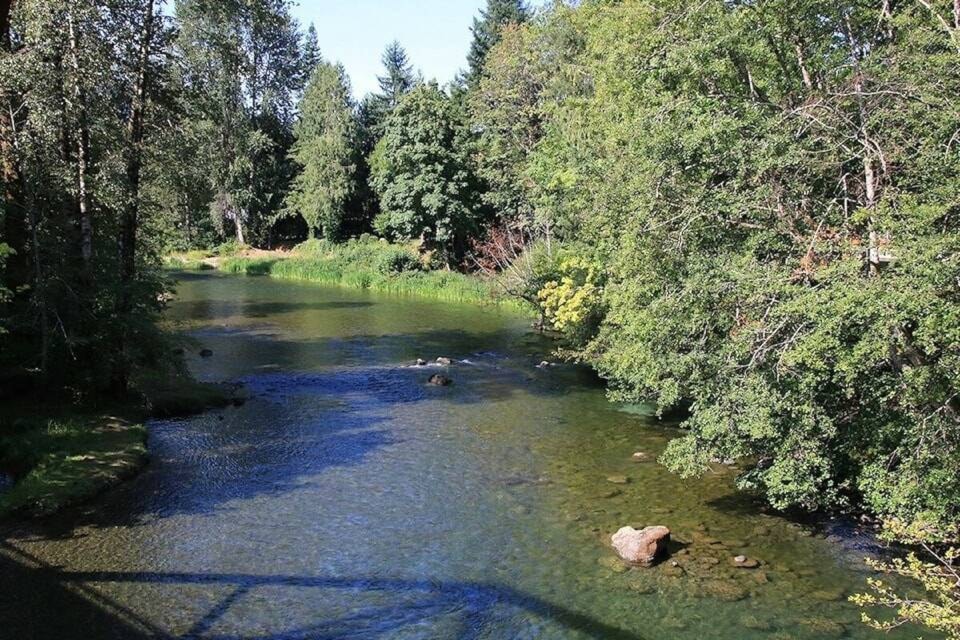As the drought continues in the region, further water conservation measures are now in effect, or are being contemplated.
As of Aug. 24, the province is temporarily restricting water use for industry and forage crops in the Koksilah River watershed, and the fishing closure on the Cowichan River will be extended, in an effort to protect fish populations in the rivers.
The Cowichan region is currently in Drought Level 5, the highest level in B.C.
The Koksilah River has seen persistent low-stream flows that are threatening the survival of steelhead trout populations, and this order is intended help restore water flow levels and protect this fish species.
This order falls under the Water Sustainability Act’s purpose of population level threats to fish species.
Approximately 108 surface and groundwater licence holders and transitioning groundwater-use applicants in the Koksilah River watershed must stop using water for forage crops, which include grass for hay and silage, alfalfa and forage corn — which is corn grown for forage purposes — including grazing, silage and earlage.
Water use for industrial purposes, as outlined in the protection order, must also cease.
The order does not apply to water diverted and used for non-forage crops, such as market vegetables, livestock watering or domestic purposes.
It also does not apply to water users that are supported by off-stream water storage.
RELATED STORY: WATER SYSTEMS IN COWICHAN REGION IN CRITICAL SHAPE, WATERSHED BOARD WARNS
The order may be revoked if water flows recover.
“The irrigation of forage crops is one of the most water-intensive agricultural water uses,” a government press release said.
“Affected farmers can access programs, such as the federal-provincial AgriStability program, which helps producers with significant drops in income or increased expenses. The Ministry of Agriculture and Food, in collaboration with the federal government, is also ensuring that producers who did not enrol in AgriStability by the April 30 deadline are still eligible for late participation and can receive financial assistance.”
Producers must have declared farm income for tax purposes to be eligible to enrol in AgriStability.
To help farmers and producers to access hay and feed, the Ministry of Agriculture and Food is working with the BC Cattlemen’s Association on the new Access to Feed program.
Through this program, the BCCA is matching sellers of hay and feed domestically across Canada and the western United States with B.C. farmers.
RELATED STORY:OFFICIALS WORRY ABOUT WATER AS DROUGHT HITS THE MAX IN COWICHAN
“These decisions are always made as a last resort in recognition of the impact on people and businesses,” the press release said.
“Because of the collective efforts of water licensees in the area, the province has been able to delay these actions until today. Provincial staff are monitoring the situation and working to balance water uses with environmental flow needs.”
To further support conservation efforts in the Cowichan Valley, the fishing closure on the upper Cowichan River is being extended into the fall season.
The angling closure extends from the Cowichan Lake weir dam to the 66 Mile Trestle located in Cowichan River Provincial Park.
Although this section of river was initially scheduled to open for angling on Sept. 1, the order extends the closure period to Nov. 15.
“Ongoing drought conditions, in combination with sustained hot-water temperatures, have led to the development of significant algal bloom in the Upper Cowichan River,” the province said.
“This bloom has led to reduced water quality, creating adverse conditions for fish and the aquatic ecosystem in the upper Cowichan River and causing significant fish mortality in the upper Cowichan River over an area of at least 10 kilometres. The goal of this extended closure is to alleviate additional stress on fish populations and allow for the recovery of the river’s aquatic ecosystem.”
Water used to extinguish a fire or contain and control the spread of a fire remains exempt by provisions under the Water Sustainability Act, so these orders will not apply to water that is used to control the spread of wildfires.
However, people under an evacuation order due to wildfire must leave the area immediately.
As well, the Cowichan Valley Regional District said the high drought level will certainly mean adverse impacts on the socio-economic activities in the region, as well as local ecosystems.
RELATED STORY: CVRD MOVES TO STAGE 3 WATERING RESTRICTIONS
“Urgent water conservation measures are required immediately to avoid Stage 4 water restrictions and its potential impacts on all residents and businesses,” the CVRD said.
“The public is urged to decrease water consumption. Our local ecosystems are counting on all of us to conserve water. Every drop counts.”
The district recommends that people use low-flow shower heads and take shorter showers; don’t run the tap to make water cold and use a pitcher of water in the fridge instead; use aerators on your taps; run dishwashers and laundry only when full; and re-use gently used water for non-essentials, like plants and lawns.
Under Stage 3 water restrictions, which the region is currently under, sprinkling with conventional irrigation systems and sprinklers of lawns, vegetable gardens, fruit trees, ornamental trees, shrubs and flower gardens is not permitted.
However, hand watering or micro-drip irrigation of vegetable gardens and fruit trees are permitted fours a day, and ornamental trees, shrubs and flower gardens are allowed for two hours per day.
The filling of pools and hot tubs is not permitted, while the washing of vehicles, boats, driveways, houses and sidewalks is only permitted under certain circumstances.

